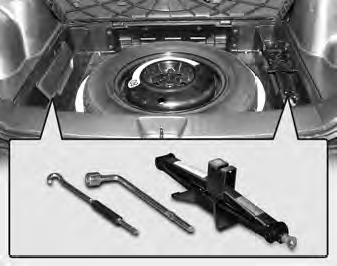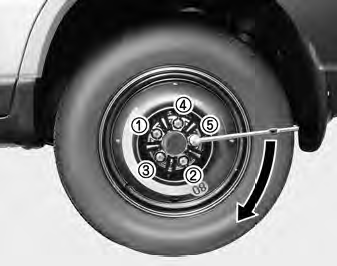 Kia Sportage: If you have a flat tire
Kia Sportage: If you have a flat tire

The spare tire, jack, jack handle, wheel lug nut wrench are stored in the luggage compartment. Remove the luggage under tray out of the way to reach this equipment.

Removing the spare tire Turn the tire hold-down wing bolt counterclockwise. Store the tire in the reverse order of removal. To prevent the spare tire and tools from “rattling” while the vehicle is in motion, store them properly. Important - use of compact spare tire your vehicle is equipped with a compact spare tire. This compact spare tire takes up less space than a regular- size tire. This tire is smaller than a conventional tire and is designed for temporary use only.
CAUTION • You should drive carefully when the compact spare is in use. The compact spare should be replaced by the proper conventional tire and rim at the first opportunity. • The operation of this vehicle is not recommended with more than one compact spare tire in use at the same time.
CAUTION This spare tire should be used only for VERY short distances. Compact spares should NEVER be used for long drives or extended distances.
The compact spare should be inflated to 420 kPa (60 psi).
NOTICE Check the inflation pressure after installing the spare tire. Adjust it to the specified pressure, as necessary.
When using a compact spare tire, observe the following precautions: • Under no circumstances should you exceed 80 km/h (50 mph); a higher speed could damage the tire. • Ensure that you drive slowly enough for the road conditions to avoid all hazards. Any road hazard, such as a pothole or debris, could seriously damage the compact spare. • Any continuous road use of this tire could result in tire failure, loss of vehicle control, and possible personal injury. • Do not exceed the vehicle’s maximum load rating or the load-carrying capacity shown on the sidewall of the compact spare tire. • Avoid driving over obstacles. The compact spare tire diameter is smaller than the diameter of a conventional tire and reduces the ground clearance approximately 25 mm (1 inch), which could result in damage to the vehicle. • Do not take this vehicle through an automatic car wash. • This tire should not be installed on the front axle if the vehicle must be driven in snow or on ice. • Do not use the compact spare tire on any other vehicle because this tire has been designed especially for your vehicle. • The compact spare tire’s tread life is shorter than a regular tire. Inspect your compact spare tire regularly and replace worn compact spare tires with the same size and design, mounted on the same wheel.

Changing tires Jacking instructions The jack is provided for emergency tire changing only. Follow jacking instructions to reduce the possibility of personal injury.
WARNING - Changing tires • Never attempt vehicle repairs in the traffic lanes of a public road or highway. • Always move the vehicle completely off the road and onto the shoulder before trying to change a tire. The jack should be used on level firm ground. If you cannot find a firm, level place off the road, call a towing service company for assistance. • Be sure to use the correct front and rear jacking positions on the vehicle; never use the bumpers or any other part of the vehicle for jack support. • The vehicle can easily roll off the jack causing serious injury or death. No person should place any portion of their body under a vehicle that is supported only by a jack ; use vehicle support stands. • Do not start or run the engine while the vehicle is on the jack. • Do not allow anyone to remain in the vehicle while it is on the jack. • Make sure any children present are in a secure place away from the road and from the vehicle to be raised with the jack.

Tire replacement 1. Park on a level surface and apply the parking brake firmly. 2. Shift the shift lever into R (Reverse) with manual transaxle or P (Park) with automatic transaxle. 3. Activate the hazard warning flasher.

4. Remove the wheel lug nut wrench, jack, jack handle, and spare tire from the vehicle. 5. Block both the front and rear of the wheel that is diagonally opposite the jack position.
WARNING - Changing a tire • To prevent vehicle movement while changing a tire, always set the parking brake fully, and always block the wheel diagonally opposite the wheel being changed. • It is recommended that the wheels of the vehicle be chocked, and that no person should remain in a vehicle that is being jacked.

6. Loosen the wheel lug nuts counterclockwise one turn each, but do not remove any nut until the tire has been raised off the ground.

7. Place the jack at the front or rear jacking position closest to the tire you are changing. Place the jack at the designated locations under the frame. The jacking positions are plates welded to the frame with two tabs and a raised dot to index with the jack.
WARNING - Jack location To reduce the possibility of injury, be sure to use only the jack provided with the vehicle and in the correct jack position; never use any other part of the vehicle for jack support.

8. Insert the jack handle into the jack and turn it clockwise, raising the vehicle until the tire just clears the ground. This measurement is approximately 30 mm (1.2 in). Before removing the wheel lug nuts, make sure the vehicle is stable and that there is no chance for movement or slippage. 9. Remove the wheel lug nuts by turning them counterclockwise, then remove the wheel. 10. Mount the spare tire into position and install the wheel lug nuts with the beveled edge inward.

11. Once the wheel lug nuts have been tightened, lower the vehicle fully to the ground and continue to tighten the lug nuts until they are fully secured. Tighten the wheel lug nuts firmly in a “star” pattern. If you are unsure of the tightness of the wheel lug nuts, have them checked at the nearest service station. The specified tightening torque is 9~11 kg•m (65-79 lb•ft, 88-107 N•m). Improperly tightened wheel lug nuts could cause brake pedal vibration while braking.
CAUTION Your vehicle has metric threads on the wheel studs and nuts. Make certain during wheel removal that the same nuts removed are reinstalled - or, if replaced, that nuts with metric threads and the same chamfer configuration are used. Installation of a non-metric thread nut on a metric stud or vice-versa will not secure the wheel to the hub properly and will damage the stud so that it must be replaced. Note that most lug nuts do not have metric threads. Be sure to use extreme care in checking for thread style before installing aftermarket lug nuts or wheels. If in doubt, consult an Authorized Kia Dealer.
WARNING - Wheel studs If the studs are damaged, they may lose their ability to retain the wheel. This could lead to the loss of the wheel and a collision resulting in serious injuries.
To prevent the jack, jack handle, wheel lug nut wrench and spare tire from rattling while the vehicle is in motion, store them properly.
WARNING - Inadequate spare tire pressure Check the inflation pressures as soon as possible after installing the spare tire. Adjust it to the specified pressure, if necessary. Refer to Section 8, Specifications.
 Towing
Towing
If emergency towing is necessary, we recommend having it done by an authorized
Kia dealer or a commercial tow-truck service. Proper lifting and towing procedures
are necessary to prevent damage ...
 Maintenance
Maintenance
Maintenance services Maintenance schedule Explanation of scheduled maintenance
items Owner maintenance Engine compartment Engine oil and oil filter Engine cooling
system Brakes and clutch Parking ...
See also:
Wheels
If a wheel is bent, cracked or heavily corroded, it should be
replaced.
Otherwise, the tire may separate from the wheel or cause loss of
handling control.
■ Wheel selection
When replacing w ...
Service mode
In service mode, the remote start function
is temporarily disabled to prevent the
system from unexpectedly starting the
engine while being serviced. ...
Safety precautions
- For safety reasons, avoid operating
the cell phone while driving.
- Do not make a phone call while
driving. When you have an incoming
call, stop the vehicle in a
safe location before ta ...
